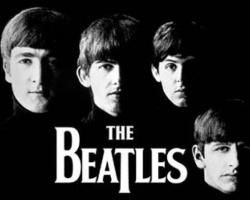It’s impossible to give an account of Western life in the 1960s without somewhere referencing the Beatles. Not only were they the most popular group of the decade with their music permeating every area of life, but they seemed to encapsulate the era from its joyous early optimism through consciousness-altering experimentation to eventual disillusionment, bickering and fragmentation.
When they began recording in 1962, American rock and roll had lost its early bite. Elvis had gone to Hollywood, Little Richard had gone to church, Chuck Berry had gone to jail, and Buddy Holly had gone to his grave. Into the vacated space came various Billys, Tommys and Bobbys who had the right haircuts but the wrong attitude. The Beatles took the original American rock-and-roll style, brought back the bite, Anglicized it a little, and sold it to the world.
Perhaps because of their more complete education (John Lennon had been to art school and Paul McCartney had studied advanced-level English literature) they were able not only to write their own songs but to progress artistically in terms of range, depth, and innovation. They made the previously unheard-of transition from touring pop idols to recording studio artists.
Rubber Soul (1965) saw them incorporate subjects other than love; Revolver (1966) displayed a complex musical imagination that drew on styles ranging from chamber music and Motown to folk and the avant-garde; and Sgt. Pepper’s Lonely Hearts Club Band (1967), the first album to be made after their retirement from live performance, was consciously produced as a work of recorded art rather than as a template for future concerts.
Along with Bob Dylan and the Rolling Stones, the Beatles dominated the popular music of the 1960s and their choices of fashion, girlfriends, drugs, music and belief were highly influential on Baby Boomers. Each album they released was anticipated as a new indication of the way forward for a generation desperate for leadership in a time of uncertainty.
In spiritual terms, the Beatles were a paradox. On the one hand they were irreverent, openly atheistic, and symptomatic of the break with so-called traditional values. When John Lennon claimed in 1966 that the Beatles were “more popular than Jesus,” he vocalized the fears of many believers, fears that had already been expressed in books like David A. Noebel’s Communism, Hypnotism and the Beatles (1965).
On the other hand, they represented the youthful quest for a meaningful spirituality that offered transcendence, beauty, love, freedom and social justice. Their widely publicized experimentation with drugs (mainly cannabis and LSD) was not a mere search for kicks but an attempt to gain perceptions that would make sense of life. Timothy Leary, the Harvard professor turned acid guru, said in his book The Politics of Ecstasy that they were “philosopher-poets of the new religion” and that their songs were “delicate hymns of glory to God.”
In 1968, at the urging of George Harrison, who had fallen in love with all things Indian, the Beatles went to Rishikesh to study Transcendental Meditation under the personal tutelage of Maharishi Mahesh Yogi. It was during this period of study that they wrote much of the double album The Beatles (better known as The White Album), which was appropriately more simple than their recent creations and had a plain, white cover that suggested the blankness of a mind cleared of the sort of thoughts that Maharishi said kept us bound to the “gross level” of existence.
If the Beatles had a core message, it was that we need to rise above the petty issues that bog us down by enlarging our field of consciousness. As John put it in “Revolution,” we’ve got to free our minds. Yet such a message manifests itself only after careful scrutiny, because the band members’ instinct was to write from the perspective of the altered state of mind rather than to command others to achieve it. The magical realism of “Penny Lane,” which turned a mundane area of Liverpool into a blue-sky paradise, practiced the freed mind whereas “Rain” and “Tomorrow Never Knows” preached it.
Christians were ill-equipped to deal with the Beatles’ phenomenon. Rather than judging them by their artistic achievements, integrity and handling of truth, many Christians dismissed them as unworthy idols and misguided heathens. Rather than sensitively evaluating their records, they burned them. The Beatles’ view that salvation was possible through an expanded consciousness may have been wrong, but it was a view worth countering intelligently rather than flinging it to the flames.
The Beatles are an object lesson to anyone endeavoring to incorporate his or her worldview into art. Most of the time they were unaware that this was what they were doing, but it’s probably this lack of self-consciousness that made them so effective. The ideas that were poured into their minds just came out naturally through their lips and fingertips. They didn’t make a statement; they became a statement.
Who are the men, women, films, TV shows, books, computer games and other pop culture icons from the last 60 years that have shaped us in theological ways? That’s the question that Robert Johnston, Craig Detweiler and Barry Taylor sought to answer in their new book Don’t Stop Believin’: Pop Culture and Religion from Ben-Hur to Zombies.




